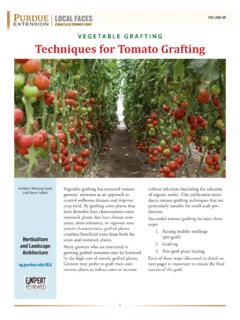Transcription of 20 Success Stories of Agricultural Innovation from the ...
1 20 Success Stories ofAgricultural Innovationfrom theInnovation FairPREFACEOne of the objectives of The International Symposium on Agricultural Innovation for Family Farmers: Unlocking the potential of Agricultural Innovation to achieve the Sustainable Development Goals, held at the Food and Agriculture Organization of the United Nations (FAO) Headquarters in Rome, 21-23 November 2018, was to celebrate inspiring Success Stories of Innovation and innovators. One of the ways to do this was through an Innovation Fair, which showcased the 20 Success Stories gathered in this booklet of Agricultural Innovation for family farmers and/or by family Innovation Fair explored how and why Agricultural Innovation happens and benefits family farmers.
2 This booklet, in the same way as the Fair, aims to increase the understanding of Innovation in agriculture and its key role to achieve the Sustainable Development that purpose, Success Stories presented in the Fair provide excellent examples of the key drivers that lead to successful Innovation , without neglecting the obstacles and challenges that had to be faced and overcome before the innovations were brought into use. The cases show the impact that these Agricultural innovations have made in people s the Fair, each Success story had a presenter and a dedicated space in the FAO Atrium.
3 Presenters were available to discuss with participants about their Innovation and Success story. They talked in an informal way about the constraints they faced, as well as the drivers that led to Innovation and Success . The selection of Success Stories presented at the Innovation Fair aimed to encompass and capture a broad range of innovations that are being used in the different Agricultural sectors (crop, livestock, fisheries and aquaculture, forestry). Most of them came from a call for FAO staff to propose successful examples of Agricultural Innovation based on their wide experience and knowledge in different fields of expertise and regions.
4 The majority of those selected were not from FAO s work. FAO/Alessia Pierdomenico2 The definition of Agricultural Innovation that FAO used for the Symposium is: Agricultural Innovation is the process whereby individuals or organisations bring new or existing products, processes or ways of organisation into use for the first time in a specific context in order to increase effectiveness, competitiveness, resilience to shocks or environmental sustainability and thereby contribute to food security and nutrition, economic development or sustainable natural resource management.
5 Novelty is a key aspect of the definition, although the products, processes and ways of organisation may already exist, they are new to the individuals or organisations who are bringing them into use in a given location and context for the first time. Also, it is not restricted to use of technologies but also use of social, organisational, institutional or marketing processes or arrangements. Further details on the definition are available at Success Stories revolve around the use of Agricultural Innovation to address four key challenges : climate change; sustainable natural resource management; food insecurity, hunger and malnutrition; and job creation, with a focus on youth.
6 Preparation of this booklet was led by FAO s Office for Corporate Communication, with support from the Symposium Secretariat and the Innovation Fair presenters. The name and affiliation of the Innovation Fair presenters are provided at the end of each story. All in all, this booklet aims to replicate to a certain degree what the Innovation Fair represented, a unique space to explore key questions and issues of Agricultural Innovation around the world. FAO/Alessia Pierdomenico3 GROWING FOOD IN IMPOSSIBLE PLACESHOW ADAPTED HYDROPONIC SOLUTIONS HELP COMMUNITIES TO STRENGHTEN LIVELIHOODS BY GROWING FOOD ANYWHERETHE SITUATIONS ahrawi refugees and their descendants have inhabited refugee camps in the Algerian Saharan desert for over 40 years, the consequence of a protracted refugee crisis.
7 In these areas, temperatures often soar to 50 degrees Celsius, water is scarce and there is limited availability of grazing lands. Traditionally nomads, the Sahrawi raise livestock as part of their livelihoods. Animal products are an essential part of their diet but because there is limited fodder to feed their goats and sheep, these animals usually end up eating leftovers and rubbish, leading to poor quantity and quality of meat and milk DRIVERST aleb, a Sahrawi refugee with an Agricultural engineering background, in 2016, came up with the idea of testing the hydroponic technique in the refugee camps, as any other traditional agriculture method was not possible in arid desert areas.
8 The World Food Programme Innovation Accelerator helped the refugees to develop a localized low-tech hydroponic unit that could be sourced and managed locally to grow barley fodder for their INNOVATIONLow-tech hydroponics enable plant growth in arid environments with a soilless cultivation technique. It is a livelihood-smart and cost-efficient solution that uses up to 90 percent less water and 75 percent less space. With the H2 Grow project, the Sahrawi refugees in the Algerian Sahara desert have tested and adapted a high-tech hydroponic system to a sustainable low-tech, locally produced hydroponic unit, which provides fodder supply for their livestock year round.
9 In 2018, the H2 Grow project has also started with a local adaptation in Eastern Chad, in the Sudanese refugee camps and it is also being piloted in Internally Displaced People (IDP) camps in Darfur, Sudan, in collaboration with CHALLENGESE xtreme weather and scarcity of water are a constant challenge for households to grow crops year-round and provide for their families and livestock. In local markets, vegetables and fodder are either not available or not affordable. The H2 Grow project is continuously exploring different solutions to overcome these challenges, also by leveraging its partnerships with FAO, governments, academia, NGOs such as OXFAM, and the communities to develop and deploy the most adapted and affordable solution to every context, considering local constraints and IMPACTH2 Grow is now being implemented in 9 countries - Peru, Algeria, Jordan, Chad, Sudan, Kenya, Namibia, Mali and Niger - reaching 5000 people amongst refugees.
10 IDPs and urban communities living in vulnerable areas, of which 75 percent are female participants. From sprouting green fodder in deserts to fresh vegetables in urban slums, with H2 Grow, communities are growing food in impossible places and strengthening their livelihood with new options of low-cost dietary diversity and expanded sources of income. Innovation FAIR PRESENTER: Nina Schr der, Co-Founder H2 Grow/Scale-up Enablement Manager, United Nations World Food Programme (WFP), WFP Innovation Accelerator, Munich, Germany Nina Schr der Nina Schr der4A-MAIZE-ING!












